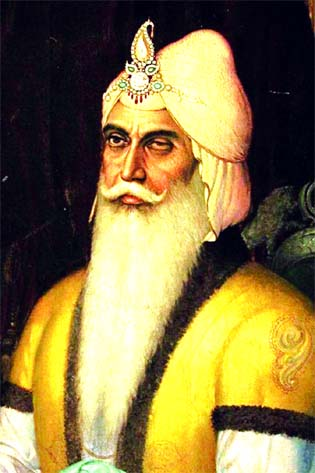Indian History
Maharaja Ranjit Singh
- 18 Aug 2021
- 4 min read
Why in News
Recently, the statue of Maharaja Ranjit Singh which was installed in 2019, vandalised by a member of radical outfit Tehrik-e-Labbaik Pakistan (TLP), a religious organisation at the Lahore Fort in Pakistan’s Punjab province.
Key Points
- Early Life:

- He was born on 13th November, 1780 in Gujranwala, now in Pakistan.
- He was the only child of Maha Singh, on whose death in 1792 he became chief of the Shukerchakias, a Sikh group.
- His inheritance included Gujranwala town and the surrounding villages, now in Pakistan.
- Contribution:
- Founder of the Sikh Empire:
- He was the founder of the Sikh Empire by overthrowing Misls.
- At that time, Punjab was ruled by powerful chieftains who had divided the territory into Misls.
- Misls refers to the sovereign states of the Sikh Confederacy that rose during the 18th century in the Punjab region in the northern part of the Indian subcontinent after the collapse of the Mughal Empire.
- He ruled the northwest Indian subcontinent in the early half of the 19th century.
- He was given the title Lion of Punjab (Sher-e-Punjab) for his success in freeing Lahore (his capital) from the Afghan invaders.
- He was the founder of the Sikh Empire by overthrowing Misls.
- Modernization of Army:
- He combined the strong points of the traditional Khalsa army with western advances in warfare to raise Asia’s most powerful indigenous army of that time.
- He also employed a large number of European officers, especially French, to train his troops.
- He appointed a French General to modernize his army.
- Wide Empire:
- Ranjit Singh’s trans-regional empire (spread over several states) included the former Mughal provinces of Lahore and Multan besides part of Kabul and the entire Peshawar.
- The boundaries of his state went up to Ladakh — in the northeast, Khyber pass (route the foreign rulers took to invade India) in the northwest, and up to Panjnad in the south where the five rivers of Punjab fell into the Indus.
- Founder of the Sikh Empire:
- Legacy:
- The Maharaja was known for his just and secular rule. Both Hindus and Muslims were given powerful positions in his darbar.
- He turned Harimandir Sahib at Amritsar into the Golden Temple by covering it with gold.
- He is also credited with funding Hazoor Sahib gurudwara at the final resting place of Guru Gobind Singh in Nanded, Maharashtra.
- Death:
- He died at Lahore in June 1839, almost exactly 40 years after he entered the city as a conqueror.
- In little more than six years after his death, the Sikh state he had created collapsed because of the internecine strife of rival chiefs.
- International Recognition:
- In 2016, the town of St Tropez in France unveiled the maharaja’s bronze statue as a mark of respect.
- His throne is displayed prominently at the Victoria and Albert Museum in London.
- In 2018, London hosted an exhibition that focused on the history of the Sikh Empire and the international relations forged by the Maharaja.






